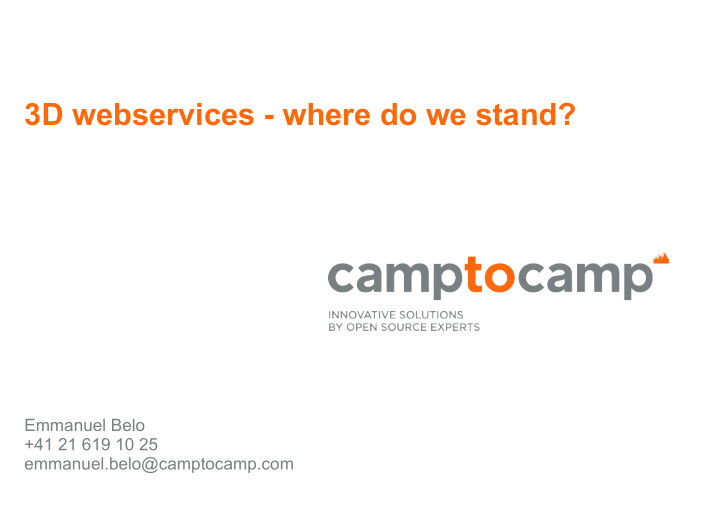



3D webservices - where do we stand? Emmanuel Belo +41 21 619 10 25 emmanuel.belo@camptocamp.com
Camptocamp ■ Open Source Service Provider ■ Staff 49 ■ Switzerland, France & Austria Wien ■ Since 2001 Lausanne Chambéry 2/37
Camptocamp: 3 divisions 3/37
Google Maps 4/37
Google Maps 5/37
Here maps (Nokia) 6/37
OpenWebGlobe 7/37
Cesium 8/37
Geospatial 3D Web expectations? ■ 3D Scenes ○ Aerial imagery and terrain ○ Buildings with textures ○ Label and marker ○ Rich interaction (Navigate, pick, popup, measure, usw.) ○ Global perimeter, higher local resolution ■ Technology ○ Web (no plugin), Cross Platform and Cross Device ○ Open Standards and Formats ○ Open Source ■ What's available? 9/37
Web ? 10/37
WebGL ! ■ Web Graphics Library ■ Javascript API for rendering interactive 2D/3D graphics withing the webbrowser ■ Hardware acceleration using the Graphics Processing Unit (GPU) ■ WebGL Programs consist of : ○ Control code written in Javascript (CPU) and ○ Shader code that is executed on a computer's GPU ■ No Plugin ! Also in IE11 !!! ■ Mobile device ready : Firefox, Sony Android Browser, Opera 11/37
Open Standards ? 12/37
Standardizing and Merging worlds ■ Geo: OGC ○ 3D Portrayal Services (Proposals: WVS WMS-Like & W3DS WFS-Like) ○ KML – XML/COLLADA ○ CityGML - representation, storage, and exchange ○ CZML (AGI/Cesium) ? ■ Geo: OSGEO ○ TMS (Cesium Terrain Server z.B) ■ Web: Web3d ○ X3D - Extensible 3D Graphics ■ Graphics: Khronos Group ○ COLLADA – eXchange / interoperability ○ glTF – graphic language Transmission Format 13/37
3D Portrayal Service (3DPS) ■ Goal: ○ Standard service interface to visualize very large 3D geospatial databases online vie Web-Browser and Mobile Devices ○ 3D Scenegraph and image based rendering 14/37
Model Challenges ■ Compact object representation ○ Bandwith ■ Progressive transfert ○ Streaming ○ LOD ■ Fast Model Display ○ GPU intensive, reduce CPU usage ■ Application/Software independent ○ Standard Mesh encodings for X3DOM:Recent Advances by Max Limper and Johannes Behr, Fraunhofer IGD 16/37
X3D Geometries ■ Basic primitives (Box, Cone Cylinder, Sphere) ■ IndexedFaceSet (3D shape formed by constructing faces - polygons) <IndexedFaceSet coordIndex='0 11 12 -1 12 1 0 -1 etc /> <Coordinate point='0.7000 1.2000 0.0000, 0.6930 1.2177 0.0000, etc /> ○ => Large HTML pages, CPU + Loading time ■ X3dom optimizations ○ Binary Geometry employs several files to store the index and geometry data directly in the requested precision ○ Progressively Ordered Primitive (POP) Buffer 17/37
CZML - Cesium Language ■ Describes ○ Graphical scene ○ Time-dynamic data ■ Caracteristics ○ JSON structure ○ Line, points, markers, models ○ Describes changes over time ○ Supports datastreaming ○ Extensible 18/37
glTF graphic language Transmission Format ■ JSON used to describe node hierarchy ■ Node hierarchy refers to EXTERNAL binary asset blobs ○ Geometry, Texturen, Material ■ Non-compressed asset blob format ○ Direct load in WebGL ■ Extensible ○ Streaming and compression 20/37
Open Source Software ? 21/37
Open Source implementations ■ PostGIS – stores and exports 3D data ○ Export X3D data: ST_AsX3D ■ Geoserver ○ Provides a W3DS API (getScene & getTile) ○ X3D & Cesium Terrain API ■ X3dom ○ JS API for displaying and interacting with X3D data ■ Three.JS ○ Rich 3D model visualisation ■ OpenWebGlobe & CesiumJS ○ Full geospatial suites to process and display/interact with 3D in the Web 22/37
PostGIS/Geoserver W3DS/X3D/X3DOM 23/37
X3DOM ■ Experimental Open Source Framework ■ Display 3D models with WebGL ■ Web3D & W3C Standardizing Process ■ Goal : 3D objects in the Web ■ Easy to use (HTML5 DOM) ■ Supports HTML Events (Ex : OnClick) 24/37
X3DOM – JS Library 25/37
Three.JS ■ Lightweight xBrowser JS library/API ■ Goal : create and display animated 3D computer graphics on a Web browser. ■ HTML5 SVG/WebGL ■ Proprietary format + glTF 27/37
Three.JS examples QGIS export (c) http://anitagraser.com/ Procedural city (c) http://mrdoob.com 28/37
OpenWebGlobe ■ Helps you to create your own virtual globe applications running plug-in free in a web browser ■ Allows the visualization of large scale image, elevation or other geospatial data ■ OpenSource (MIT License) 29/37
CesiumJS ■ Javascript Software with WebGL for displaying ○ 3D virtual globe ○ 2D map ○ 2.5D Collombus View ■ Time-dynamic Scenes with CZML ■ Multiple terrain sources ■ Overlays : ○ Raster : WMS, TMS, OSM, Bing & Esri ○ Vector : glTF, CZML, KML, Shapefiles ■ Extensible with plugins 30/37
Cesium – 3 views, WebGL 31/37
CZML 3D + time-dynamic display 32/37
Cesium – Terrain + Overlay 33/37
Cesium Sandcastle 34/37
OpenLayers 3 – Cesium Integration 35/37
Conclusion ■ High activity in the 3D WebGL domain ○ Big Players set public expectations ○ Ongoing standardizations efforts ○ WebGL momentum (Microsoft is now on board) ■ Consider : ○ Dataquantity to be stored and processed in the backend ○ Data transfer and streaming with different LODs ○ Deliver data for the GPU, avoid CPU processing AND Provide access to semantics for the CPU ○ Web3D implementations have limited encoding possibilities applied to the geospatial world 36/37
Recommend
More recommend